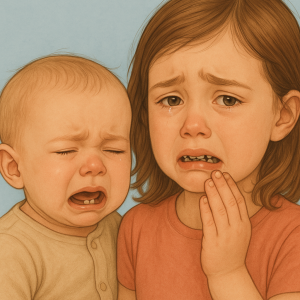According to BMC Oral Health (2018), 85% of children aged 2–5 in Abu Dhabi have active dental caries. In a region known for high living standards and advanced healthcare, this statistic is nothing short of alarming.
1. Caries is an Infectious Process
Dental caries in young children isn’t just a cavity—it’s an infectious disease driven by the bacterium Streptococcus mutans. These microbes colonize the tooth surface and biofilm, produce acids, and gradually break down enamel from within. Early childhood caries can lead to pain, sleep disturbances, poor nutrition, and even impaired growth.
2. Everyday Habits That Spread Infection
The primary culprit is Streptococcus mutans, which spreads through common family behaviors:
2.1. Licking and “Taste-Testing” Utensils
- Pacifiers and spoons: Parents often taste baby food or moisten a pacifier with their own saliva, transferring thousands of S. mutans cells directly into the child’s mouth.
- Bottles and nipples: Licking the nipple before offering it again creates the same risk, especially for nighttime feedings.
2.2. Breathing and Kisses
- Kisses on the lips: A quick kiss may seem affectionate but directly passes adult saliva—and its bacteria—to the child.
- Cheek kisses and close contact: Even non-oral kisses and speech droplets can settle on skin, toys, or shared surfaces, later finding their way into little mouths.
2.3. Shared Hygiene Items and Dishes
- Toothbrushes in one cup: Rinsing a brush sprays saliva-laden droplets onto neighboring brushes.
- Communal rinsing cups: One cup for everyone guarantees exchange of saliva.
- Shared utensils and dishes: Without thorough washing, these instantly become bacterial carriers.
Study Highlight: Mattos-Graner et al. (2001) found that 71% of initial colonization cases of S. mutans in children derived directly from their mothers.
3. Bacteria and Sugar: A Deadly Love Affair with Enamel
We all crave sweets—kids reach for cookies and lollipops, adults sweeten their coffee—but for S. mutans, sugar is a feast:
- Sugar as fuel: Simple carbohydrates (glucose, fructose, sucrose) dissolve in saliva and feed bacteria.
- Acid production: Through glycolysis, S. mutans converts sugars into pyruvate, then in low-oxygen conditions (inside dental plaque) into lactic, acetic, and propionic acids.
- Acid “attacks” enamel: Once pH drops below 5.5, acids leach calcium and phosphate from hydroxyapatite crystals—this is demineralization, the first step in caries formation.
- 20–30 minute risk window: After consuming sugar, pH remains low for about half an hour until saliva balances it back to neutral (6.8–7.2). Without brushing or rinsing, enamel continues to demineralize.
- No sugar—no acid: Without fermentable carbohydrates, S. mutans can’t produce damaging acids, keeping enamel safe.
Bottom line: To protect your child’s (and your own) teeth, cut off sugar at the source and reinforce enamel with fluoride and remineralizing treatments.
4. Taking Action — Five Simple Steps for the Whole Family
Caries isn’t inevitable. With a few smart changes and some family teamwork, you can turn the tide:
1. Stop Sharing Germs
- No more licking pacifiers or spoons.
- Replace kisses on the lips with hugs or cheek kisses.
- Store toothbrushes in individual holders or cases—never all in one cup.
2. Sugar Only as a Treat
- Remove candies, cookies, cakes, and packaged juices from the daily menu.
- Introduce fresh fruits, berries, vegetable sticks, plain yogurt, and cottage cheese instead.
- Drink only water or unsweetened tea—doing it together makes it easier.
3. Regular Dental Check-Ups
- Children, pregnant women, smokers, and diabetics: every 4 months.
- Everyone else: biannually.
Early visits catch problems before pain starts.
4. Professional Cleaning, Swiss-Quality
At True Smile Dental Center, we follow the Guided Biofilm Therapy protocol with top Swiss equipment:
- AIR-FLOW® Plus for gentle biofilm removal.
- Ultrasonic scaling for hard deposits.
- Final polishing and fluoride application.
Plus Cone-Beam CT when needed—analyzed by both our dentists and AI for pinpoint accuracy.
5. Sealant Shield for New Molars
As soon as your child’s first permanent molars erupt (around ages 6–7), we apply a fluoride-rich sealant into grooves to block decay—up to 88% effective.
5. At-Home Oral Care: A Clear “How-To” Guide
By Age Group
- 0–2 years: Use a soft silicone brush or gauze; clean twice daily—after feeding and before bedtime.
- 2–4 years: Switch to a small-head, soft-bristle brush; pea-sized fluoride toothpaste (1000 ppm); brush under adult supervision.
- 20–30 months and beyond: Once second baby molars appear, introduce flossing between teeth; children can learn to floss independently by ages 7–10 with guidance.
Brushing Technique
- Hold the brush at a 45° angle to the gumline.
- Use gentle circular strokes—no hard scrubbing.
- Cover chewing, outer, and inner surfaces.
- Don’t forget the tongue—bacteria accumulate there too.
Extra Support for Parents
- Rinse with water after meals or fruit snacks.
- Parents should finish off their child’s brushing until ages 7–10 to ensure thorough plaque removal and reinforce good technique.
6. The True Smile Dental Center Difference
- Guided Biofilm Therapy (GBT):
- AIR-FLOW® Plus and ultrasonic scaling on Swiss equipment.
- Polishing and fluoride application for maximum enamel protection.
- Routine Exams with AI Insight:
- Visual assessment of gums and teeth.
- Cone-Beam CT scans analyzed by both our dentists and advanced AI to catch hidden issues.
- Sealants for Permanent Molars:
- Applied as soon as first permanent molars erupt (6–7 years).
- A thin, lasting shield against decay in deep grooves.
- Personalized Prevention Plans:
- Customized dietary and home-care guidance.
- Family packages with discounts and ongoing motivation.
7. Family Challenge: Healthy Smiles Together
- Commit as a family to a low-sugar lifestyle: swap sweets for fruits, hydrate with water and tea.
- Treat and prevent caries together—shared success lowers the household’s overall S. mutans load.
- Family plans come with up to 15% savings.




